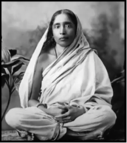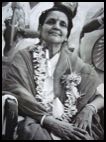Spiritual-Teaching.org
Letter # 7 - Reorientation
“Sri Ramana would not engage with questioners about free will and predestination. Though both theories appear contradictory, they do however reflect the truth to some degree. Sri Ramana would always bring the questioner back to the central point of our existence: Who is this who thinks they are predestined or who has free will?”
In the weeks following the decision to stay at Sri
Ramana Nagar, I was still unsure and slightly dazed by
the radical change in my plans such as they were. It
never again occurred to me to move from the tawdry
small cell I was living in and seek adventures
elsewhere in India and beyond. Reflecting on it now, I
see that my immediate life at Arunachala was in some
way fixed like that of a train on railway tracks. Once
that initial decision to stay crystalized in my mind, a
whole slew of future decisions was immediately lined
up and fell naturally into place. There are crucial
moments in our lives which dictate the aftermath of
what will happen to us. An easy example is a student
who decides to become a doctor rather than a lawyer. A
whole new chain of experiences will automatically be
lined up as possibilities. There may be differences in
how it unfolds but the main theme may hold for the rest
of one’s life. I did not know then that that commitment
to stay would dictate the remainder of my existence in
this world. One decision taken in one minute decided
the general course of my future.
After about a week outside the ashram, I started
to sporadically sit in the Old Hall but for some reason
one day in the late afternoon I climbed up the lower
slopes of Arunachala and saw two people,
Rajapalayalam Ramani Ammal and an old
gentleman dressed in kasaya (orange cloth), who I
later learned was Kunju Swami, one of the senior
swamis in the ashram who had been with Bhagavan
since 1920.
They were sitting on a large flattish rock chatting. I
sat down on a nearby rock and watched them in the
crepuscular light as it slowly died down on Arunachala.
It was sandhya, which happens four times a day. They
are midnight, predawn, noon and in the late afternoon
as the sun sets. These times are especially conducive
for meditation, particularly early morning when our vital
forces are naturally in balance.
On recollection, in that dying light, I sat feeling
defeated in a way. It wasn’t possible to go forward nor
could I go back. I was stuck with myself with no means
of amusement or diversions to keep the dogs of
depression away. A substantial pressure slowly
enveloped my brain until it felt like a dead weight. The
emotional pain was excruciating. There was nowhere
to run and even if I could make a decision, my body
was numb as if it were deep underwater enduring a
compression of indefinable heaviness. The
envelopment soon lifted and with it came the insight
that I was helpless in the face of superior forces of
which I had almost no inkling let alone control. The
days when I thought I was captain of my fate seemed l
laughable.
It is hard, particularly for those educated with the
Western attitudes that say we freely make our own
decisions and can do what we like to fulfil our
ambitions, to realise that we are pawns of fate. Sri
Ramana said that our prarabdha karma (Fate
or the result of our accumulated past actions that bear
fruit in this life) has already been set in place when we
are born. That everything is preordained. The one
choice we have is whether to identify with it or not. This
is anathema to anyone who values freedom, chance
and endless possibilities.
There is a famous incident in the life of Sri
Ramana Maharshi when his mother came to
Tiruvannamalai to plead with him to come back to the
family home in Madurai. Sri Ramana Mahahsi was in
silence and wrote in response the following and I quote
from Arthur Osborne’s book Ramana Maharshi and the
Path of Self Knowledge.
“The Ordainer controls the fate of souls in
accordance with their prarabdhakarma ( destiny to be
worked out in this life, resulting from the balance sheet
of actions in past lives). Whatever is destined not to
happen will not happen, try as you may. Whatever is
destined to happen will happen, do what you may to
prevent it. This is certain. The best course, therefore, is
to remain silent.”
Sri Ramana would not engage with questioners
about free will and predestination.Though both theories
appear contradictory, they do however reflect
the truth to some degree. Sri Ramana would always
bring the questioner back to the central point of our
existence: Who is this who thinks they are predestined o
or who has free will?
In Hinduism, there is the concept of twice-born
(dvija). There is our natural,physical life and then there
is another life which opens up with the ceremonies of
what is called the upanayana initiation ceremony
where the initiate is secretly given the sacred Gayatri
mantra. As a sign of that ceremony, the initiate is
invested with a multithread that loops next to the skin
over the left shoulder and across the right hip.
This investiture is not limited to those of a certain
religious caste who engage in a public ceremony. All
who enter a genuine spiritual life, experience a decisive
moment that divides their former life from the
new chapter that opens. They are invested with a mark
that indicates that they are now members of a
dedicated group of seekers. Depending on whether
one is a member of a formal religious order be it say,
Hindu, Buddhist, Muslim or Christian, or if one is a
solitary seeker who is outside the purview of these
institutions, the ‘mark’ will be appropriate to the school.
In recognized religions, there is the physical attire
which conveys to others that the person is nominated
but there is also an invisible one which only another
initiate can ‘see’.
In the circle of Sri Ramana, those who had been
initiated by Sri Ramana knew who the others were. But
they all kept quiet. There was no need to speak as it
served no purpose for others to know what would not
be of help to them but would create jealousy and
bickering as to who was initiated and who was not.
Unlike say the outstanding Ramakrishna Math edifice,
Sri Ramana’s ‘organisation’ is not strictly structured.
There is no rigid hierarchy, there are no certificates.
But that does not mean Sri Ramana does not oversee
the progress of his disciples. Quite the contrary, he
does it in mysterious ways. Sri Ramana is not blatant
but subtly exercises his Grace. We are forever left with
a slight doubt every time he works his miracles. Each
one he performs could be seen as a natural
occurrence without any overt display.
That is Bhagavan’s style…nothing flashy.
Returning to the question of free will and
predestination, the question becomes irrelevant once
the authentic initiation occurs. The physical unfoldment
will not change, the body will still undergo the results of
former actions but there is a radical and dramatic shift
of perspective. Life becomes meaningful. The suffering
which previously appeared gratuitous and unfair now
becomes significant. The anguish we endure becomes
useful experience or knowledge that helps us see our
way free of the seemingly blind forces that inhabit our
existence. We use the difficulty to become free.
___________________________________________


